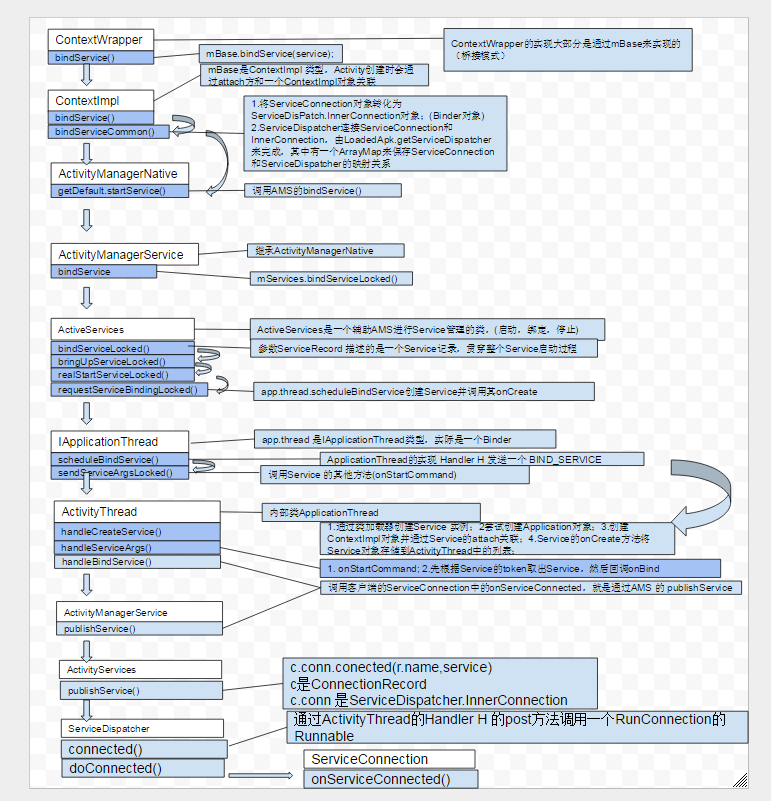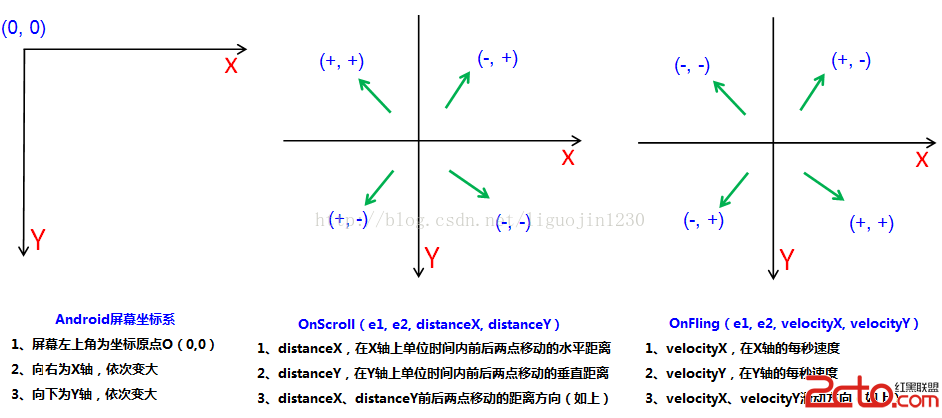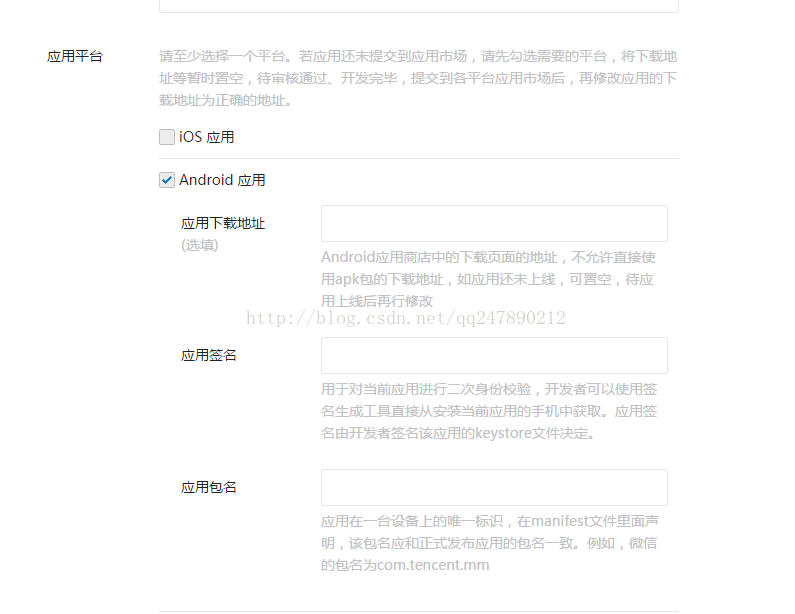編輯:關於Android編程
Service分為兩種工作狀態,一種是啟動狀態,主要用於執行後台計算;另一種是綁定狀態,主要用於其他組件和Service的交互。這兩種狀態可以共存的,即Service既可以處於啟動狀態也可以同時處於綁定狀態。
本篇博客是對Service的啟動過程和綁定過程進行源碼分析。

從ContextWrapper的startService開始:
@Override
public ComponentName startService(Intent service) {
return mBase.startService(service);
}
mBase的類型是ContextImpl。
@Override
public ComponentName startService(Intent service) {
warnIfCallingFromSystemProcess();
return startServiceCommon(service, mUser);
}
private ComponentName startServiceCommon(Intent service, UserHandle user) {
try {
validateServiceIntent(service);
service.prepareToLeaveProcess();
ComponentName cn = ActivityManagerNative.getDefault().startService(
mMainThread.getApplicationThread(), service, service.resolveTypeIfNeeded(
getContentResolver()), getOpPackageName(), user.getIdentifier());
if (cn != null) {
if (cn.getPackageName().equals("!")) {
throw new SecurityException(
"Not allowed to start service " + service
+ " without permission " + cn.getClassName());
} else if (cn.getPackageName().equals("!!")) {
throw new SecurityException(
"Unable to start service " + service
+ ": " + cn.getClassName());
}
}
return cn;
} catch (RemoteException e) {
throw new RuntimeException("Failure from system", e);
}
}
由上可知,startServiceCommon通過ActivityManagerNative.getDefault()(AMS)這個對象啟動一個Service。通過AMS來啟動服務的行為是一個遠程調用過程。
AMS#startService
@Override
public ComponentName startService(IApplicationThread caller, Intent service,
String resolvedType, String callingPackage, int userId)
throws TransactionTooLargeException {
enforceNotIsolatedCaller("startService");
// Refuse possible leaked file descriptors
if (service != null && service.hasFileDescriptors() == true) {
throw new IllegalArgumentException("File descriptors passed in Intent");
}
if (callingPackage == null) {
throw new IllegalArgumentException("callingPackage cannot be null");
}
if (DEBUG_SERVICE) Slog.v(TAG_SERVICE,
"startService: " + service + " type=" + resolvedType);
synchronized(this) {
final int callingPid = Binder.getCallingPid();
final int callingUid = Binder.getCallingUid();
final long origId = Binder.clearCallingIdentity();
ComponentName res = mServices.startServiceLocked(caller, service,
resolvedType, callingPid, callingUid, callingPackage, userId);
Binder.restoreCallingIdentity(origId);
return res;
}
}
AMS會通過mService來完成Service後續的啟動過程,mService對象的類型是ActivityServices,是一個輔助AMS進行Service管理的類,包括Service的啟動、綁定和停止等。在ActivityServices的startServiceLocked方法會調用startServiceInnerLocked方法,startServiceInnerLocked方法繼續調用bringUpServiceLocked方法,bringUpServiceLocked方法又調用realStartServiceLocked方法。
private final void realStartServiceLocked(ServiceRecord r,
ProcessRecord app, boolean execInFg) throws RemoteException {
if (app.thread == null) {
throw new RemoteException();
}
if (DEBUG_MU)
Slog.v(TAG_MU, "realStartServiceLocked, ServiceRecord.uid = " + r.appInfo.uid
+ ", ProcessRecord.uid = " + app.uid);
r.app = app;
r.restartTime = r.lastActivity = SystemClock.uptimeMillis();
final boolean newService = app.services.add(r);
bumpServiceExecutingLocked(r, execInFg, "create");
mAm.updateLruProcessLocked(app, false, null);
mAm.updateOomAdjLocked();
boolean created = false;
try {
if (LOG_SERVICE_START_STOP) {
String nameTerm;
int lastPeriod = r.shortName.lastIndexOf('.');
nameTerm = lastPeriod >= 0 ? r.shortName.substring(lastPeriod) : r.shortName;
EventLogTags.writeAmCreateService(
r.userId, System.identityHashCode(r), nameTerm, r.app.uid, r.app.pid);
}
synchronized (r.stats.getBatteryStats()) {
r.stats.startLaunchedLocked();
}
mAm.ensurePackageDexOpt(r.serviceInfo.packageName);
app.forceProcessStateUpTo(ActivityManager.PROCESS_STATE_SERVICE);
app.thread.scheduleCreateService(r, r.serviceInfo,
mAm.compatibilityInfoForPackageLocked(r.serviceInfo.applicationInfo),
app.repProcState);
r.postNotification();
created = true;
} catch (DeadObjectException e) {
Slog.w(TAG, "Application dead when creating service " + r);
mAm.appDiedLocked(app);
throw e;
} finally {
if (!created) {
// Keep the executeNesting count accurate.
final boolean inDestroying = mDestroyingServices.contains(r);
serviceDoneExecutingLocked(r, inDestroying, inDestroying);
// Cleanup.
if (newService) {
app.services.remove(r);
r.app = null;
}
// Retry.
if (!inDestroying) {
scheduleServiceRestartLocked(r, false);
}
}
}
requestServiceBindingsLocked(r, execInFg);
updateServiceClientActivitiesLocked(app, null, true);
// If the service is in the started state, and there are no
// pending arguments, then fake up one so its onStartCommand() will
// be called.
if (r.startRequested && r.callStart && r.pendingStarts.size() == 0) {
r.pendingStarts.add(new ServiceRecord.StartItem(r, false, r.makeNextStartId(),
null, null));
}
sendServiceArgsLocked(r, execInFg, true);
if (r.delayed) {
if (DEBUG_DELAYED_STARTS) Slog.v(TAG_SERVICE, "REM FR DELAY LIST (new proc): " + r);
getServiceMap(r.userId).mDelayedStartList.remove(r);
r.delayed = false;
}
if (r.delayedStop) {
// Oh and hey we've already been asked to stop!
r.delayedStop = false;
if (r.startRequested) {
if (DEBUG_DELAYED_STARTS) Slog.v(TAG_SERVICE,
"Applying delayed stop (from start): " + r);
stopServiceLocked(r);
}
}
}
在realStartServiceLocked方法中,首先通過app.thread的scheduleCreateService方法來創建Service對象並調用其onCreate,接著調用sendServiceArgsLocked方法來調用Service的其他方法,比如onStartCommand,這兩個過程均是進程間的通信。具體實現是ApplicationThread。
ApplicationThread#scheduleCreateService
public final void scheduleCreateService(IBinder token,
ServiceInfo info, CompatibilityInfo compatInfo, int processState) {
updateProcessState(processState, false);
CreateServiceData s = new CreateServiceData();
s.token = token;
s.info = info;
s.compatInfo = compatInfo;
sendMessage(H.CREATE_SERVICE, s);
}
這個過程和Activity的啟動類似。發送消息給Handler H,H接受消息H.CREATE_SERVICE並通過ActivityThread的handleCreateService方法來完成Service的啟動。
ActivityThread#handleCreateService
private void handleCreateService(CreateServiceData data) {
// If we are getting ready to gc after going to the background, well
// we are back active so skip it.
unscheduleGcIdler();
LoadedApk packageInfo = getPackageInfoNoCheck(
data.info.applicationInfo, data.compatInfo);
Service service = null;
try {
java.lang.ClassLoader cl = packageInfo.getClassLoader();
service = (Service) cl.loadClass(data.info.name).newInstance();
} catch (Exception e) {
if (!mInstrumentation.onException(service, e)) {
throw new RuntimeException(
"Unable to instantiate service " + data.info.name
+ ": " + e.toString(), e);
}
}
try {
if (localLOGV) Slog.v(TAG, "Creating service " + data.info.name);
ContextImpl context = ContextImpl.createAppContext(this, packageInfo);
context.setOuterContext(service);
Application app = packageInfo.makeApplication(false, mInstrumentation);
service.attach(context, this, data.info.name, data.token, app,
ActivityManagerNative.getDefault());
service.onCreate();
mServices.put(data.token, service);
try {
ActivityManagerNative.getDefault().serviceDoneExecuting(
data.token, SERVICE_DONE_EXECUTING_ANON, 0, 0);
} catch (RemoteException e) {
// nothing to do.
}
} catch (Exception e) {
if (!mInstrumentation.onException(service, e)) {
throw new RuntimeException(
"Unable to create service " + data.info.name
+ ": " + e.toString(), e);
}
}
}
主要完成了以下四件事:
1. 首先通過類加載器創建Service的實例
2. 然後創建Appliction對象並調用其onCreate
3. 接著調用ContextImpl對象並通過Service的attach方法建立二者的關系,和Activity的類似。
4. 最後調用Service的onCreate方法並將Service對象存儲到ActivityThread中的一個列表中。
由於Service的onCreate被執行,意味著Service已經啟動,除此之外,ActivityThread中還會通過handleServiceArgs方法調用Service的onStartCommand方法。
private void handleServiceArgs(ServiceArgsData data) {
Service s = mServices.get(data.token);
if (s != null) {
try {
if (data.args != null) {
data.args.setExtrasClassLoader(s.getClassLoader());
data.args.prepareToEnterProcess();
}
int res;
if (!data.taskRemoved) {
res = s.onStartCommand(data.args, data.flags, data.startId);
} else {
s.onTaskRemoved(data.args);
res = Service.START_TASK_REMOVED_COMPLETE;
}
QueuedWork.waitToFinish();
try {
ActivityManagerNative.getDefault().serviceDoneExecuting(
data.token, SERVICE_DONE_EXECUTING_START, data.startId, res);
} catch (RemoteException e) {
// nothing to do.
}
ensureJitEnabled();
} catch (Exception e) {
if (!mInstrumentation.onException(s, e)) {
throw new RuntimeException(
"Unable to start service " + s
+ " with " + data.args + ": " + e.toString(), e);
}
}
}
}
Service的綁定過程也是從ContextWrapper開始。
@Override
public boolean bindService(Intent service, ServiceConnection conn,
int flags) {
return mBase.bindService(service, conn, flags);
}
ContextImpl#bindServiceCommon
private boolean bindServiceCommon(Intent service, ServiceConnection conn, int flags,
UserHandle user) {
IServiceConnection sd;
if (conn == null) {
throw new IllegalArgumentException("connection is null");
}
if (mPackageInfo != null) {
sd = mPackageInfo.getServiceDispatcher(conn, getOuterContext(),
mMainThread.getHandler(), flags);
} else {
throw new RuntimeException("Not supported in system context");
}
validateServiceIntent(service);
try {
IBinder token = getActivityToken();
if (token == null && (flags&BIND_AUTO_CREATE) == 0 && mPackageInfo != null
&& mPackageInfo.getApplicationInfo().targetSdkVersion
< android.os.Build.VERSION_CODES.ICE_CREAM_SANDWICH) {
flags |= BIND_WAIVE_PRIORITY;
}
service.prepareToLeaveProcess();
int res = ActivityManagerNative.getDefault().bindService(
mMainThread.getApplicationThread(), getActivityToken(), service,
service.resolveTypeIfNeeded(getContentResolver()),
sd, flags, getOpPackageName(), user.getIdentifier());
if (res < 0) {
throw new SecurityException(
"Not allowed to bind to service " + service);
}
return res != 0;
} catch (RemoteException e) {
throw new RuntimeException("Failure from system", e);
}
}
首先將客戶端的ServiceConnection對象轉化為ServiceDispather.InnerConnection對象。因為服務的綁定有可能是跨進程的,ServiceConnection必須借助Binder才能讓遠程服務端回調自己的方法,ServiceDispather.InnerConnection剛好充當了Binder。ServiceDispather起連接ServiceConnection和InnerConnection的作用。此過程由LoadedApk的getServiceDispather方法完成。
LoadedApk#getServiceDispather
public final IServiceConnection getServiceDispatcher(ServiceConnection c,
Context context, Handler handler, int flags) {
synchronized (mServices) {
LoadedApk.ServiceDispatcher sd = null;
ArrayMap map = mServices.get(context);
if (map != null) {
sd = map.get(c);
}
if (sd == null) {
sd = new ServiceDispatcher(c, context, handler, flags);
if (map == null) {
map = new ArrayMap();
mServices.put(context, map);
}
map.put(c, sd);
} else {
sd.validate(context, handler);
}
return sd.getIServiceConnection();
}
}
mService是一個ArrayMap存儲了一個應用當前活動的ServiceConnection和ServiceDispatcher的映射關系。
系統首先會查找是否存在相同的ServiceConnection,若不存在,則重新創建一個ServiceDispatcher對象並將其存儲在mService中,在ServiceDispatcher內部又保存了ServiceConnection和InnerConnection對象。當Service和客戶端建立連接後,系統會通過InnerConnection來調用ServiceConnection中的onServiceConnected方法,這個過程可能跨進程。當ServiceDispatcher創建好以後,getServiceDispatcher會返回其保存的InnerConnection對象。
AMS#bindService
public int bindService(IApplicationThread caller, IBinder token, Intent service,
String resolvedType, IServiceConnection connection, int flags, String callingPackage,
int userId) throws TransactionTooLargeException {
enforceNotIsolatedCaller("bindService");
// Refuse possible leaked file descriptors
if (service != null && service.hasFileDescriptors() == true) {
throw new IllegalArgumentException("File descriptors passed in Intent");
}
if (callingPackage == null) {
throw new IllegalArgumentException("callingPackage cannot be null");
}
synchronized(this) {
return mServices.bindServiceLocked(caller, token, service,
resolvedType, connection, flags, callingPackage, userId);
}
}
接下來AMS會調用ActivityServices的startServiceLocked方法。在ActivityServices的startServiceLocked方法會調用startServiceInnerLocked方法,startServiceInnerLocked方法繼續調用bringUpServiceLocked方法,bringUpServiceLocked方法又調用realStartServiceLocked方法。最終通過ApplicationThread來完成Service實例的創建並執行onCreate方法,和啟動Service不同的是,Service的綁定過程會調用app.thread的scheduleBindService方法。
public final void scheduleBindService(IBinder token, Intent intent,
boolean rebind, int processState) {
updateProcessState(processState, false);
BindServiceData s = new BindServiceData();
s.token = token;
s.intent = intent;
s.rebind = rebind;
if (DEBUG_SERVICE)
Slog.v(TAG, "scheduleBindService token=" + token + " intent=" + intent + " uid="
+ Binder.getCallingUid() + " pid=" + Binder.getCallingPid());
sendMessage(H.BIND_SERVICE, s);
}
在H內部收到BIND_SERVICE,會交給ActivityThread的handleBindService方法來處理。
ActivityThread#handleBindService
private void handleBindService(BindServiceData data) {
Service s = mServices.get(data.token);
if (DEBUG_SERVICE)
Slog.v(TAG, "handleBindService s=" + s + " rebind=" + data.rebind);
if (s != null) {
try {
data.intent.setExtrasClassLoader(s.getClassLoader());
data.intent.prepareToEnterProcess();
try {
if (!data.rebind) {
IBinder binder = s.onBind(data.intent);
ActivityManagerNative.getDefault().publishService(
data.token, data.intent, binder);
} else {
s.onRebind(data.intent);
ActivityManagerNative.getDefault().serviceDoneExecuting(
data.token, SERVICE_DONE_EXECUTING_ANON, 0, 0);
}
ensureJitEnabled();
} catch (RemoteException ex) {
}
} catch (Exception e) {
if (!mInstrumentation.onException(s, e)) {
throw new RuntimeException(
"Unable to bind to service " + s
+ " with " + data.intent + ": " + e.toString(), e);
}
}
}
}
在handleBindService中,首先根據Service的token取出Service對象,然後調用Service的onBind方法,Service的onBind方法返回一個Binder對象給客戶端使用。原則上來說,Service的onBind方法調用後Service就被綁定成功,但是onBind方法是Service的方法,這個時候客戶端並不知道已經成功連接Service,所以還要調用客戶端的ServiceConnection中的onServiceConnected,這是由AMS的publishService方法完成。
Service有一個特性,當多次綁定同一個Service時,Service的onBind方法只會執行一次,除非Service被終止。當Service的onBind執行以後,系統還需要告知客戶端已經成功連接Service了。由AMS的publishService方法完成。
AMS#publishService
public void publishService(IBinder token, Intent intent, IBinder service) {
// Refuse possible leaked file descriptors
if (intent != null && intent.hasFileDescriptors() == true) {
throw new IllegalArgumentException("File descriptors passed in Intent");
}
synchronized(this) {
if (!(token instanceof ServiceRecord)) {
throw new IllegalArgumentException("Invalid service token");
}
mServices.publishServiceLocked((ServiceRecord)token, intent, service);
}
}
由上可知,AMS的publishService方法將具體的工作交給了ActiveServices類型的mService對象來處理。
void publishServiceLocked(ServiceRecord r, Intent intent, IBinder service) {
final long origId = Binder.clearCallingIdentity();
try {
if (DEBUG_SERVICE) Slog.v(TAG_SERVICE, "PUBLISHING " + r
+ " " + intent + ": " + service);
if (r != null) {
Intent.FilterComparison filter
= new Intent.FilterComparison(intent);
IntentBindRecord b = r.bindings.get(filter);
if (b != null && !b.received) {
b.binder = service;
b.requested = true;
b.received = true;
for (int conni=r.connections.size()-1; conni>=0; conni--) {
ArrayList clist = r.connections.valueAt(conni);
for (int i=0; i
核心代碼c.conn.connected(r.name, service); 其中c是ConnectionRecord;c.conn是ServiceDispatcher.InnerConnection,Service就是Service的onBind返回的Binder對象。
LoadedApk#ServiceDispatcher#InnerConnection
private static class InnerConnection extends IServiceConnection.Stub {
final WeakReference mDispatcher;
InnerConnection(LoadedApk.ServiceDispatcher sd) {
mDispatcher = new WeakReference(sd);
}
public void connected(ComponentName name, IBinder service) throws RemoteException {
LoadedApk.ServiceDispatcher sd = mDispatcher.get();
if (sd != null) {
sd.connected(name, service);
}
}
}
InnerConnection的connected方法調用ServiceDispatcher的connected方法。
LoadedApk#ServiceDispatcher#connected
public void connected(ComponentName name, IBinder service) {
if (mActivityThread != null) {
mActivityThread.post(new RunConnection(name, service, 0));
} else {
doConnected(name, service);
}
}
ServiceDispatcher的mActivityThread是ActivityThread中的Handler H。如此,RunConnection就可以經由H的post方法從而運行在主線程中,因此客戶端的ServiceConnection中的方法是在主線程被回調的。
private final class RunConnection implements Runnable {
RunConnection(ComponentName name, IBinder service, int command) {
mName = name;
mService = service;
mCommand = command;
}
public void run() {
if (mCommand == 0) {
doConnected(mName, mService);
} else if (mCommand == 1) {
doDeath(mName, mService);
}
}
final ComponentName mName;
final IBinder mService;
final int mCommand;
}
顯然,RunConnection的潤方法也是簡單的調用了ServiceDispatcher的doConnected方法,由於ServiceDispatcher內部保存了客戶端的ServiceConnection對象,因此它可以很方便地調用ServiceConnection對象的onServiceConnected方法。
LoadedApk#ServiceDispatcher#doConnected
public void doConnected(ComponentName name, IBinder service) {
ServiceDispatcher.ConnectionInfo old;
ServiceDispatcher.ConnectionInfo info;
synchronized (this) {
if (mForgotten) {
// We unbound before receiving the connection; ignore
// any connection received.
return;
}
old = mActiveConnections.get(name);
if (old != null && old.binder == service) {
// Huh, already have this one. Oh well!
return;
}
if (service != null) {
// A new service is being connected... set it all up.
mDied = false;
info = new ConnectionInfo();
info.binder = service;
info.deathMonitor = new DeathMonitor(name, service);
try {
service.linkToDeath(info.deathMonitor, 0);
mActiveConnections.put(name, info);
} catch (RemoteException e) {
// This service was dead before we got it... just
// don't do anything with it.
mActiveConnections.remove(name);
return;
}
} else {
// The named service is being disconnected... clean up.
mActiveConnections.remove(name);
}
if (old != null) {
old.binder.unlinkToDeath(old.deathMonitor, 0);
}
}
// If there was an old service, it is not disconnected.
if (old != null) {
mConnection.onServiceDisconnected(name);
}
// If there is a new service, it is now connected.
if (service != null) {
mConnection.onServiceConnected(name, service);
}
}
客戶端的onServiceConnected方法執行後,Service的綁定過程也就完成了。
 手機進水怎麼辦?
手機進水怎麼辦?
當你的手機不慎掉進水裡,且你很快就把它撈出來,接下來如何“挽救”你的手機,就可以試試以下的方法。三步“營救”
 進階四之Android UI介面之(Gallery仿圖像集浏覽)
進階四之Android UI介面之(Gallery仿圖像集浏覽)
兩個人共嘗一個痛苦只有半個痛苦,兩個人共享一個歡樂卻有兩個歡樂。 本講內容:Gallery仿圖像集浏覽 一、基本原理 在 Activity 中實現 OnGest
 微信授權登陸接入第三方App(步驟總結)Android
微信授權登陸接入第三方App(步驟總結)Android
這幾天開發要用到微信授權的功能,所以就研究了一下。可是微信開放平台接入指南裡有幾個地方寫的不清不楚。在此總結一下,以便需要的人。很多微信公眾平台的應用如果移植到app上的
 swift版QQ音樂播放器(二)
swift版QQ音樂播放器(二)
一 完善部分的QQ音樂效果圖二 需要完善點1 歌曲的切換和暫停播放2 歌曲當前播放時間和歌曲總時間的更新3 進度條的處理4 歌手頭像處理5 頭像動畫效果6 歌詞的進度顯示